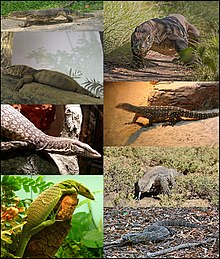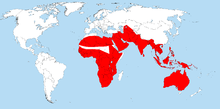
Back ورل Arabic ورل ARZ Varanus AST Varan Azerbaijani Varanus BAN Lobar BBC Gotô BCL Вараны Byelorussian Варани Bulgarian बिलगोह Bihari
| Monitor lizard Temporal range:
| |
|---|---|

| |
| Left: V. salvator, V. flavescens, V. tristis, V. prasinus Right: V. komodoensis, V. giganteus, V. albigularis, V. varius | |
| Scientific classification | |
| Domain: | Eukaryota |
| Kingdom: | Animalia |
| Phylum: | Chordata |
| Class: | Reptilia |
| Order: | Squamata |
| Family: | Varanidae |
| Genus: | Varanus Merrem, 1820 |
| Type species | |
| Varanus varius Shaw, 1790
| |
| Subgenera | |

| |
| Combined native range of all the monitor lizards | |

Monitor lizards are lizards in the genus Varanus, the only extant genus in the family Varanidae. They are native to Africa, Asia, and Oceania, and one species is also found in the Americas as an invasive species.[1] About 80 species are recognized.
Monitor lizards have long necks, powerful tails and claws, and well-developed limbs. The adult length of extant species ranges from 20 cm (7.9 in) in some species such as Varanus sparnus, to over 3 m (10 ft) in the case of the Komodo dragon, though the extinct megalania (Varanus priscus) may have reached lengths of more than 7 m (23 ft). Most monitor species are terrestrial, but many are also arboreal or semiaquatic. While most monitor lizards are carnivorous, eating smaller reptiles, fish, birds, insects, small mammals, and eggs, a few species also eat fruit and vegetation.[2]
- ^ "Monitor | lizard | Britannica". www.britannica.com. 2023-05-23. Retrieved 2023-06-06.
- ^ Bauer, Aaron M. (1998). Cogger, H.G.; Zweifel, R.G. (eds.). Encyclopedia of Reptiles and Amphibians. San Diego: Academic Press. pp. 157–159. ISBN 0-12-178560-2.